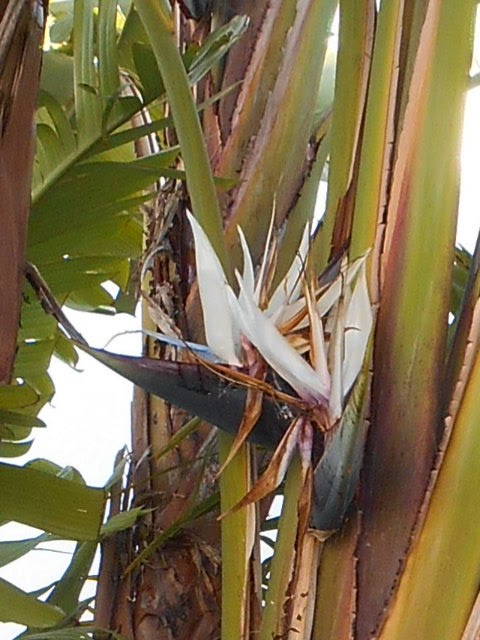 |
| Small Tortoiseshell, Aglais urticae, nectaring on cherry blossom. Kentle Wood, Daventry. 20 April, 2015 |
The flowers provide both nectar and pollen and thus attract a range of insects.
Here a Small Tortoiseshell is taking nectar but only a few bees were showing an interest.
 |
| Crab Apple blossoms were almost open at Kentle Wood, Daventry. 20 April, 2015 |
Some crab apples have been planted but this example was in a far older hedge bordering the north of the woodland. The Crab Apple, Malus sylvestris, does occur widely in Northamptonshire but many specimens may be hybrids and difficult to identify with certainty. Whatever their parentage, they are beautiful in this bud stage.
As I have remarked before, being a newly created woodland means that the ground flora of a mature woodland is absent, but this does not mean that the site lacks interest.
 |
| Glossy Bramble Pigmy mines from 2014. Kentle Wood, Daventry. 20.April, 2015 |
Familiar characters are present with this bramble leaf displaying the mines of the Glossy Bramble Pigmy, Stigmella splendidissimella. This of course is a mine from last year, but this abundant little moth will soon be back.
 |
| Veronica polita at Kentle Wood, Daventry. 20 April, 2015 |
Many insects were recorded. Most were small and not really photogenic but a notable exception was provided by Orange-tip Butterflies (Anthocharis cardamines).
 |
| A male Orange-tip butterfly, Kentle Wood Daventry 20 April, 2015 |
Pairs of these flitted about and I began to despair of getting a photograph. Finally one specimen, clearly anxious to enjoy the limelight, posed nicely on a bramble leaf. Fortunately it was the more colourful male.
 |
| A queen Vespula vulgaris at Kentle Wood, Daventry. 20.April, 2015 |
A large wasp proved to be a queen of the Common Wasp, Vespula vulgaris. She will build a small, golf-ball sized nest containing 20-30 cells and in these cells the first workers (all female) are reared. Once they emerge they take over all the general duties, except for egg-laying.
 |
| Hogweed already in flower. Kentle Wood, Daventry. 20 April, 2015 |
I was very surprised to find Hogweed, Heracleum sphondylium, already in flower. This species normally begins flowering sometime in June but it was in an area subject to mowing and this has probably disrupted its normal flowering pattern. Early insects will appreciate this source of nectar.
 |
| These leaf edges show the gall of a mite, Phyllocoptes goniothorax. Kentle Wood. 23 April, 2015 |
Some hawthorns were coming into leaf by 20 April but no sooner had the leaves unfurled (23 April) than they were under attack. This tightly rolled leaf edge, with its red coloration, is caused by a mite, Phyllocoptes goniothorax.
The shoots are frequently suffused with red, particularly when these tender leaves are under attack.
 |
| Hawthorn Shieldbug. Kentle Wood, Daventry. 23 April, 2015 |
I swept a hawthorn shrub with my net and secured this Hawthorn Shieldbug, Acanthosoma haemorrhoidale. Although by no means confined to hawthorn the colour of this bug is a perfect match for the young shoots, explaining why, prior to sweeping the bush, I hadn't noticed it. It was quickly released.
 |
| The distortion on these goosegrass leaves is caused by a mite, Cecidophyes rouhollahi. Kentle Wood. 23 April, 2015 |
Other plants were under attack. Many plants of goosegrass, Galium aparine, had distorted shoots. Again a mite is the culprit, in this case Cecidophyes rouhollahi.
My last visit of the month was on a chilly, windy and wet April 29. Not only was the weather depressing but an examination of some ash trees was even more depressing.
 |
| Black and withered leaves are an indication of Ash Dieback. Kentle Wood, Daventry. 29 April, 2015 |
Black, withered leaves on an ash tree showed clearly that it had been attacked by the fungus Hymenoscyphus pseudoalbidus. Known as Ash Dieback or Chalara, this is a disease which threatens to devastate Britain's ash trees. Many hundreds - perhaps thousands - have been planted in Kentle Wood; all are now under threat.
Also under attack was a Mountain Ash, Sorbus aucuparia. This tree, known commonly as Rowan, is unrelated to the true ash tree but has similar pinnately compound leaves.
 |
| The leaflets of Mountain Ash showing the pustules of a mite, Eriophyes pyri. Kentle Wood, Daventry. 29 April, 2015 |
The damage consisted of rounded pustules each about 2 mm across and on both surfaces of the leaflets. It is again the work of a mite, Eriophyes pyri, and appears to do no real harm.
It was now approaching noon. The sun had broken through and insects were on the wing.
 |
A clump of white bluebells (surely an oxymoron) caught my eye and I stooped down to take a photograph. These had obviously been introduced, although possibly by accident.
 |
| Male or female? It matters not. Orange-tip Butterfly, Kentle Wood, Daventry. 29 April, 2015 |
I was just straightening up when something else caught my eye. An Orange-tip Butterfly was clinging on to a flower in the still-buffeting wind. This view of the rear wings are doesn't allow identification to gender but, male or female, it was pleasing to have seen it.
April seems to be limping to a chilly and wet end but...
The driving boy, beside his team,
Of May-month's beauty now doth dream.
We are a bit short of driving boys hereabouts but we all still anticipate May much as did John Clare's lad. Roll on!




































